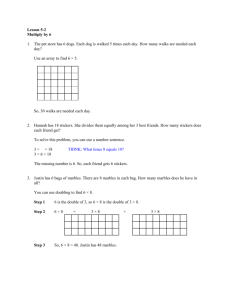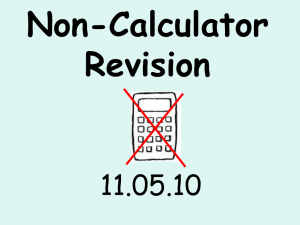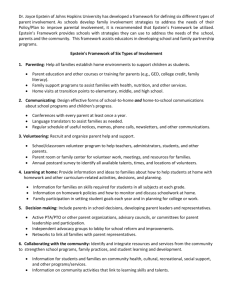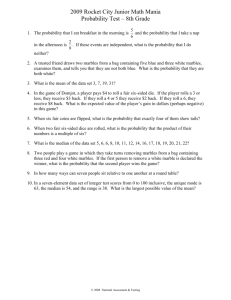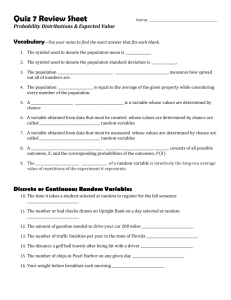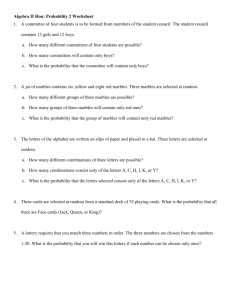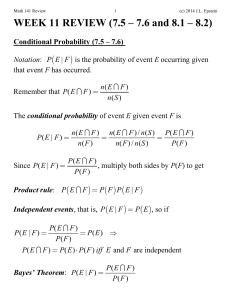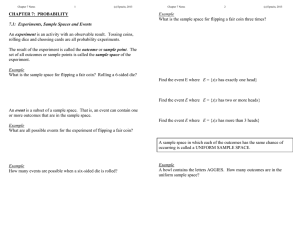( ) ( )
advertisement
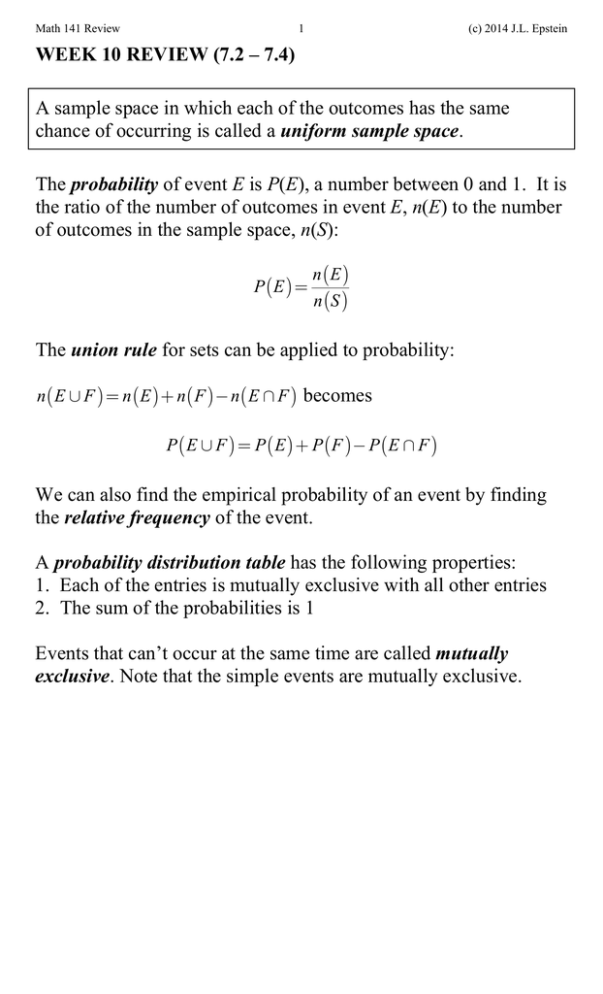
Math 141 Review
1
(c) 2014 J.L. Epstein
WEEK 10 REVIEW (7.2 – 7.4)
A sample space in which each of the outcomes has the same
chance of occurring is called a uniform sample space.
The probability of event E is P(E), a number between 0 and 1. It is
the ratio of the number of outcomes in event E, n(E) to the number
of outcomes in the sample space, n(S):
n(E )
P(E) =
n(S )
The union rule for sets can be applied to probability:
n ( E È F ) = n ( E ) + n ( F ) - n ( E Ç F ) becomes
P(E È F ) = P(E ) + P(F )- P(E Ç F )
We can also find the empirical probability of an event by finding
the relative frequency of the event.
A probability distribution table has the following properties:
1. Each of the entries is mutually exclusive with all other entries
2. The sum of the probabilities is 1
Events that can’t occur at the same time are called mutually
exclusive. Note that the simple events are mutually exclusive.
Math 141 Review
2
(c) 2014 J.L. Epstein
Example: A letter is chosen at random from the word WOOD.
How many outcomes are in the uniform sample space for this
experiment?
Example: A bowl has 3 blues and 2 red beads in it. Two beads are
chosen at random from the bowl. What is the uniform sample
space for this experiment?
Example: Suppose that S = {a, b, c} is a uniform sample space. If
E = {a, b} and F = {b, c} , what is P ( E F )?
Example: At a swim meet, 20% of the girls finished a race in less
than 25 seconds. 55% of the girls finished this same race in 30 or
fewer seconds. 15% of the girls took 35 seconds or more to finish
this race. Arrange this information into a probability distribution
table.
Math 141 Review
3
(c) 2014 J.L. Epstein
Example: Two fair six-sided dice are rolled. What is the
probability that the sum of the numbers shown uppermost is 11 or
at least one three is showing uppermost?
Example: Suppose we have a jar with 8 blue and 6 green marbles.
Find the probability distribution table for the number of blue
marbles in the sample of 2 marbles and find the probability there is
at least one blue marble.
Math 141 Review
4
(c) 2014 J.L. Epstein
Example: When shopping for a ceiling fan, you find after looking
at 100 fans that 65 of the fans have more than 4 blades, 35 of the
fans are reversible and 80 of the fans have more than 4 blades or
are reversible. What is the probability that a reversible fan has
more than 4 blades?
Example: A student takes a true/false test with 5 questions by
guessing (choose answer at random). Write a probability
distribution table for the number of correct answers.
Math 141 Review
5
(c) 2014 J.L. Epstein
Example: You are dealt 3 cards from a standard deck of 52 cards.
Find the probability distribution table for the number of spades in
your hand of 3 cards.
Example: There are 72 marbles in a box. There are 18 different
colors and 4 marbles of each color. Five marbles are chosen at
random from the box. What is the probability of a full house?
That is, 3 of one color and 2 of a different color.
Example: A coffee shop finds that 44% of its customers do not
order coffee, 16% order only coffee and 6% order only a muffin.
What is the probability that a randomly selected customer will
order coffee or a muffin?
Math 141 Review
6
(c) 2014 J.L. Epstein
Example: A box has 30 transistors and a sample of 5 is chosen for
testing to decide if the box is “good” or “bad”. A box is
considered “bad” if one or more transistors in the sample are found
to be defective. What is the probability that a box that has 4
defective transistors will be considered “good”?
Example: Matthew is studying for a Latin quiz and he learns the
meaning of 24 nouns from the list of 30. The Latin quiz has 10
nouns. If a passing grade is 7 or more, what is the probability that
Matthew passes this Latin quiz?
Example: A bowl has 3 pennies, 5 nickels and 4 quarters. Four
coins are selected at random from the bowl. What is the
probability that exactly 3 nickels or exactly one quarter is chosen?
